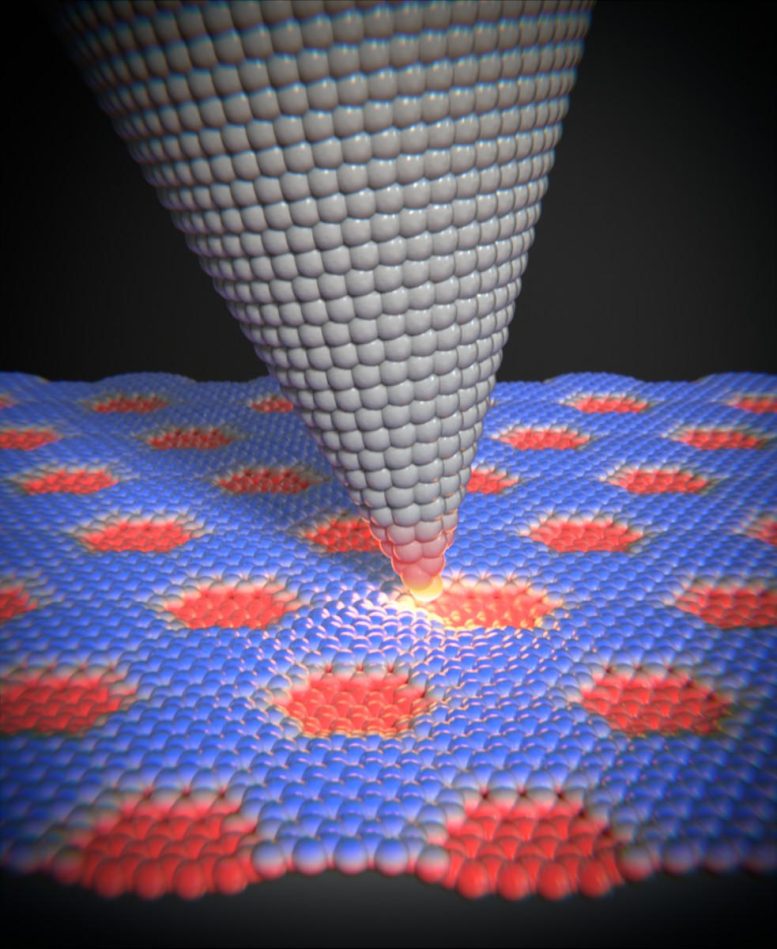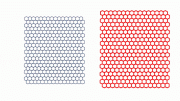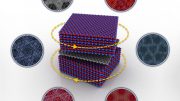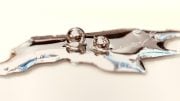
Surprisingly, the friction between the tip of an atomic force microscope and the Moiré superstructures depends on the speed at which the tip is moved across the surface. Credit: Department of Physics, University of Basel and Scixel
Researchers from Basel and Tel Aviv discovered that friction varies with speed in specific graphene structures on platinum surfaces, defying Coulomb’s law which states that friction is speed-independent in the macro world.
Materials made of single atomic layers are highly valued for their low-friction qualities, useful in reducing friction in hard disks or moving parts of satellites or space telescopes. Graphene, consisting of a single layer of carbon atoms arranged like a honeycomb, is a prime example and is under examination for its potential as a lubricating layer. Earlier studies showed that a graphene ribbon can glide almost friction-free across a gold surface.
Surprising results with a rough surface
If graphene is applied to a platinum surface, it has a significant impact on the measurable friction forces. Now, physicists from the University of Basel and Tel Aviv University have reported in the journal Nano Letters that, in this instance, the friction depends on the speed at which the tip of an atomic force microscope (AFM; see box) is moved across the surface. This finding is surprising because friction does not depend on speed according to Coulomb’s law, which applies in the macro world.
In conjunction with the platinum substrate, graphene no longer forms only the hexagonal honeycomb pattern of carbon atoms and instead forms superstructures known as Moiré superlattices. The surface is then no longer completely flat and exhibits a certain degree of roughness.
“If we move the AFM tip across this slightly corrugated surface at low speed, we measure a weak and almost constant frictional force,” explains Professor Ernst Meyer from the Swiss Nanoscience Institute and the Department of Physics at Basel University. “Above a certain threshold, however, the friction then increases with the speed of the AFM tip,” adds first author Dr. Yiming Song. “The larger the Moiré superstructure, the lower the threshold at which the friction becomes speed-dependent.”
The researchers found that there is greater resistance at the ridges of the Moiré superstructures during the movement of the tip. These ridges undergo elastic deformation due to the pushing tip before relaxing again when the pressure is sufficiently high. This effect results in greater frictional forces that increase with the speed of the tip. Simulations and an analytical model confirm the experimental findings obtained by this international team of researchers.
Reference: “Velocity Dependence of Moiré Friction” by Yiming Song, Xiang Gao, Antoine Hinaut, Sebastian Scherb, Shuyu Huang, Thilo Glatzel, Oded Hod, Michael Urbakh and Ernst Meyer, 30 November 2022, Nano Letters.
DOI: 10.1021/acs.nanolett.2c03667








Scientific research under the guidance of correct theories can make human beings less detours and less failures. Topological vortex field theory covers all short-distance and long-distance contributions of space-time motion, which is the nature of space-time motion.
Science does not stop here only to a limit God indeded to be.
Why is there always someone who wants to talk about God whenever science is mentioned?
The layer deformed, causing the tip to snag. Same thing as if you run your finger down a blanket quickly.
Not exactly unlocking the secrets of the cosmos, or disproving friction…
The big deal is friction is not variable, but they just showed it is in this specific instance, therefore new physics. What have you done lately worth mentioning?